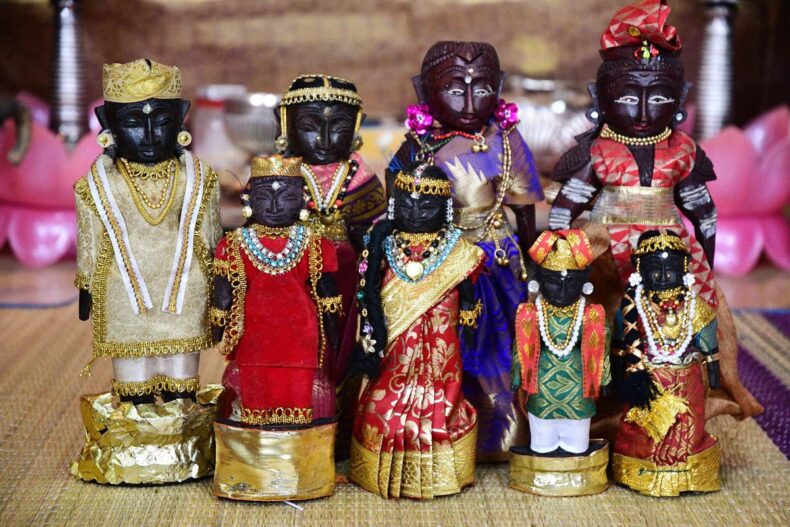They locate the valued dolls, which have been passed down through the centuries and are always kept together when Navaratri draws to a close.
A doll that is older than its owner and will likely survive longer than she does Marapachi are mysterious creatures with chiselled features and rich mahogany colouring. They come with a set of guidelines for use and storage, so owning them comes with a lot of responsibility. The first is to never split up a couple.
As they set up her marapachi collection for a portrait, Rama Venkat informs us, “We have to bring him close to her.” They can’t be separated from one another. Every golu must have dolls made of red sand. Anyone who has one of these dolls will be proud to tell you how old it is, as most of them are several decades old.
Chitra Kannan has two pairs: “One is mine, which is thirty years old, and the other is my mother’s, which must be over seventy years old,” she informs us, pointing out the differences in the two sets’ features. She remarks, “My mother’s dolls have much superior features.” Chitra received the dolls from her mother. She adds that her mother purchased them from a store close to Madurai’s Meenakshi Amman shrine, saying, “She bought me a new pair after I got married, as is the tradition.”
It’s unusual to see a son and daughter doll next to a marapachi pair, but that’s what Bharathi Santhanam has done. She smiles and says, “I built them a family. The little dolls are actually another couple. Her dolls date back to around 1950. She remembers that “my mum got them at Tirupathi when she happened to go on a pilgrimage.” The duo is dressed in outfits that Bharathi created many years ago out of glitter paper.
The dolls are given from mother to daughter for a reason. Chitra, 56, explains that they represent unity and togetherness. Because of this, she always removes them from their storage location during Navratri with careful attention to prayer.
Marapachi dolls were not only made in the shapes of men and women before the government prohibited the felling of red sanders. M Sridhar, an antiquarian with a base in Coimbatore and the creator of Indian Antique Quest, a website that sources and sells antiquities, claims that king and queen marapachi dolls were once present among other gods.
He continues, “Red sanders was chosen since the wood has therapeutic properties. They were predominantly created at Tirupathi in Andhra Pradesh because it was readily available there. It is thought to have both therapeutic and digestive qualities.
Sridhar describes how a block of the wood would be kept in the kitchen and used as a paste as needed for cuts and rashes after being rubbed in a mortar with water. According to him, some couples dressed up their marapachi in precise replicas of their wedding attire and gave the dolls to their children as teething toys. According to Sridhar, “in this way, they would immortalise their appearance on their wedding day at a time when cameras were hard to come by.”
Even before they were carved, the pair of dolls were in a relationship. They are manufactured from the same block of wood, according to Sridhar. One can see how the grains and textures blend together when put adjacent to one another. He remembers his grandmother’s rigorous instructions on how to put them away after being displayed because he owns a pair that is 120 years old. She would instruct us to cover their ears well because they probably listen to every conversation at home. “You bind them with fabric with the dolls facing each other, and never their backs to one another,” he says laughing.
Indiology and the past S Gurumurthy, a robust man, is the owner of a two-foot tall, 100-year-old couple. The 64-year-old also has a number of 200- to 300-year-old marapachi jewels in his possession. He says, “They belonged to my great grandfather. Four pairs of the dolls, one of which Rama Venkat received from her mother-in-law and is 150 years old, are among her possessions.
So,which of these marapachi couples is the most gorgeous? It’s difficult to tell because each of these dolls holds priceless memories and is incredibly personal. I would choose mine if I had to choose. Although they might not have any antique value, they were a lovely gift from someone. Eight years ago, they selected them from a small shop opposite the Parthasarathy Temple in Triplicane.












